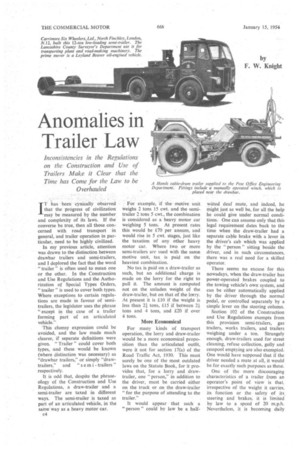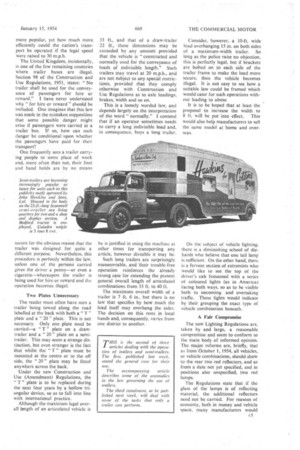Anomalies in Trailer Law
Page 42

Page 43

Page 44

If you've noticed an error in this article please click here to report it so we can fix it.
Inconsistencies in the Regulations on the Con' struction and Use of Trailers Make it Clear that the Time has Come for the Law to be Overhauled
by F. W. Knight
IT has been cynically observed that •the progress of civilization may be measured by the number and complexity of its laws. If the converse be true, then all those con-. cerned with road transport in general, and trailer operation in particular, need to be highly civilized.
In my previous article, attention was drawn to the distinction between drawbar trailers and semi-trailers, and I deplored the fact that the word " trailer " is often used to mean one or the other. In the Construction and Use Regulations and the Authorization of Special Types Orders, " trailer " is used to cover both types. Where exceptions to certain regulations are made in favour of semitrailers, the legislator uses the phrase "except in the case of a trader forming part of an articulated vehicle."
This clumsy expression could be avoided, and the law made much clearer, if separate definitions were given. " Trailer " could cover both types, and these would be known (where distinction was necessary) as "drawbar trailers," or simply "draw trailers," and "semitrailers" respectively.
It is odd that, despite the phraseology of the Construction and Use Regulations, a draw-trailer and a semi-trailer are taxed in different ways. The semi-trailer is taxed as part of an articulated vehicle, in the same way as a heavy motor car.
c4 For example, if the motive unit weighs 2 tons 15 cwt. and the semitrailer 2 tons 5 cwt., the combination is considered as a heavy motor car weighing 5 tons. At present rates this would be £70 per annum, and" would rise in 5 cwt. stages, just like the taxation of any other heavy motor car. Where two or more semi-trailers are used with the same motive unit, tax is paid on the heaviest combination.
No tax is paid on a draw-trailer as such, but an additional charge is made on the lorry for the right to pull it. The amount is computed not on the unladen weight of the draw-trailer, but on that of the lorry. At present it is £10 if the weight is less than n tons, £15 if between 21 tons and 4 tons, and £20 if over 4 tons.
More Economical
For many kinds of transport operation, the lorry and draw-trailer would be a more economical proposition than the articulated outfit, were it not for section 17(a) of the Road Traffic Act, 1930. This must surely be one of the most outdated laws on the Statute Book, for it provides that, for a lorry and drawtrailer, one "person," in addition to the driver, must be carried either on the truck or on the draw-trailer "for the purpose of attending to the trailer."
It would appear that such a " person " could by law be a half
witted deaf mute; and indeed, he Might just as well be, for all the help he could give under normal conditions. One can assume only that this legal requirement dates back to the time when the draw-trailer had a separate cable brake with a lever in the driver's cab which was applied by the " person " sitting beside the driver, and in such circumstances, there was a real need for a skilled operator.
There seems no excuse for this nowadays, when the draw-trailer has power-operated brakes coupled to the towing vehicle's ownsystem, and can be either automatically applied by the driver through the normal pedal, or controlled separately by a simple lever on the steering column.
Section 102 of the Construction and Use Regulations exempts from this provision semi-trailers, gas trailers, works trailers, and trailers weighing under a ton. Strangely enough, draw-trailers used for street cleaning, refuse collection, gully and cesspool emptying are also exempted. One would have supposed that if the driver needed a mate at all, it would be for exactly such purposes as these.
One of the more discouraging characteristics of a trailer from an operator's point of view is that: irrespective of the weight it carries, its function or the safety of its steering and brakes, it is .limited by law to a speed of 20 m.p.h. Nevertheless, it is becoming daily
more popular, yet how much more efficiently could the nation's tramport be operated if the legal speed were raised to 30 m.p.h.
The United Kingdom, incidentally, is one of the few remaining countries where trailer buses are illegal. Section 98 of the Construction and Use Regulations, 1951, states: "No trailer shall be used for the conveyance of passengers for hire or reward." I have never understood why "for hire or reward" should be included. One imagines that this law was made in the mistaken supposition that some possible danger might arise if passengers were carried in a trailer bus. If so, how can such danger be conditional upon whether the passengers have paid for their transport?
One frequently sees a trailer carrying people to some place of work and, more often than not, their foot and hand holds are by no means secure for the obvious reason that the trailer was designed for quite a different purpose. Nevertheless, this procedure is perfectly within the law, unless one of the persons carried gives the driver a penny—or even a cigarette—whereupon the trailer is being used for hire or reward and the operation becomes illegal.
Two Plates Unnecessary
The reader must often have seen a
• trailer being towed along the road labelled at the back with both a " T " plate and a "20" plate. This is not necessary. Only one plate need be carried—a " T " plate on a drawtrailer and a " 20 " plate on a semitrailer. This may seem a strange distinction, but even stranger is the fact that whilst the " T " plate must be mounted at the centre or to the off side, the " 20 " plate may be fitted anywhere across the back.
Under the new Construction and Use (Amendment) Regulations, the " T " plate is to be replaced during the next four years by a hollow tri angular device, so as to fall into line with international practice.
Although the maximum legal overall length of an articulated vehicle is 33 ft., and that of a draw-trailer 22 ft., these dimensions may be exceeded by any amount provided that the vehicle is "constructed and normally used for the conveyance of loads of indivisible length." Such trailers may travel at 20 m.p.h., and are not subject to any special restrictions, provided that they comply otherwise with Construction and Use Regulations as to axle loadings, brakes, width and so on.
This is a loosely worded law, and depends largely on the interpretation of.the word " normally." I contend that if an operator sometimes needs to carry a long indivisible load and, in consequence, buys a long trailer, he is justified in using the machine at other times for transporting any article, however divisible it may be.
Such long trailers are surprisingly manoeuvrable, and 'their trouble-free operation reinforces the already strong ease for extending the present general overall length of articulated combinations from 33 ft. to 40 ft.
The maximum overall width of a trailer is 7 ft. 6 in., but there is no law that specifies by how much the load itself may overhang the sides. The decision on this rests in local hands and, consequently, varies from one district to another. Consider, however, a 10-ft. wide load overhanging 15 in. on both sides of a maximum-width trailer. So long as the police raise no objection, this is perfectly legal, but if brackets are bolted on to each side of the trailer frame to make the load more secure, then the vehicle becomes illegal. It is not easy to see how a suitable law could be framed which would cater for such operations without leading to abuse.
It is to be hoped that at least the proposal to increase the width to 8 ft. will be put 'into effect. This would also help manufacturers to sell the same model at home and overseas.
On the subject of 'vehicle lighting, there is a diminishing school of diehards who believe that one tail lama is sufficient. On the other hand, there is a fervent section of extremists who would like to see the top of the driver's cab festooned with a series of coloured lights (as in America) facing both ways, so as to be visible both to oncoming and overtaking traffic. These lights would indicate by their grouping the exact type of vehicle combination beneath.
A Fair Compromise The new Lighting Regulations are, taken by and large, a reasonable compromise and seem to conform to the main body of informed opinion. The major reforms are, briefly, that as from October 1, 1954, all vehicles, or vehicle combinations, should show to the rear two red reflectors, and as from a date not yet specified, and in positions also unspecified, two red lamps.
The Regulations state that if the glass of the lamps is of reflecting material, the additional reflectors need not be carried. For reasons of economy, both in money and vehicle space, many manufacturers would like to take advantage of this concession. Their difficulty is that until they know where the tail lamps are to be fitted, they cannot make the necessary provision for fitting them, either in the matter of design, or of ordering the necessary supplies. The Minister of Transport should be strongly urged to declare his intentions in the matter at the earliest possible moment.
It is worth noting that the new regulations insist that lamps shall not merely be "efficient," but "clean and efficient." This naturally leads to consideration of the throwing-up of mud and water by wheels, and the Construction and Use Regulations aim very properly at its prevention.
All the wheels of an articulated vehicle must be provided with wings or similar fittings for this purpose, yet there is no legal obligation to fit wings to the front wheels of a drawtrailer. It is difficult to see where the difference lies between the latter's mud-splashing capacity as compared with the driving wheels on the centre axle of an articulated 'vehicle. In c6 both cases, the wheels are more or less shielded by the trailer body when running straight and lose this protection when the vehicle is cornering.
There are other regulations, such as those dealing with wheelhases, axle loads and parking brakes, to name but a few, which likewise contain unsatisfactory clauses. A good set of rules, for whatever purpose they are framed, should first convey clearly the legis lator's intention; secondly, they should cover all possible eventualities, and, thirdly, block all loopholes which might permit the rules to be broken in spirit whilst adhering to the letter.
Difficult .though this the many sets of regulations which govern trailer construction and operation are of ten unnecessarily vague or irrational, and the time has come when they should be thoroughly overhauled and brought into line with current practice.
The Minister had an excellent opportunity of doing so when he made the Motor Vehicles (Construction and Use) (Amendment) Regulations, 1953, but he regrettably failed to take it.
of the country.




































































































